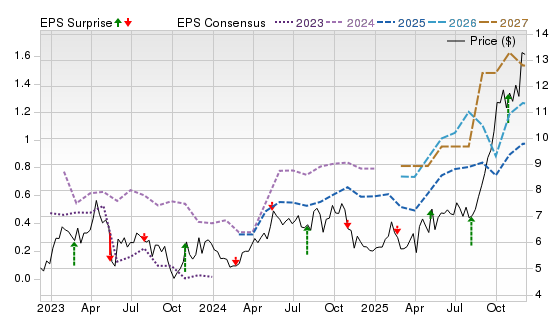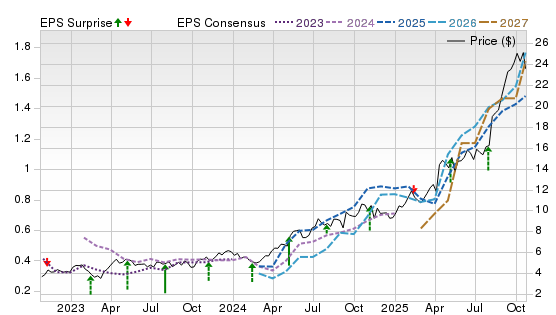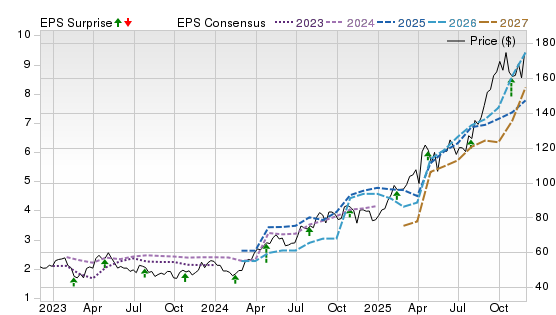5 Best Gold Stocks to Buy Today
| Company (Ticker) | 12 Week Price Change | Forward PE | Price | Proj EPS Growth (1 Year) | Projected Sales Growth (1Y) |
|---|---|---|---|---|---|
| Centerra Gold (CGAU) | 40.08% | 15.09 | $14.91 | 40.28% | 0.00% |
| Kinross Gold (KGC) | 18.51% | 17.53 | $29.27 | 147.06% | 34.74% |
| AngloGold Ashanti PLC (AU) | 27.40% | 16.28 | $89.91 | 149.10% | 70.08% |
| Agnico Eagle Mines (AEM) | 7.54% | 23.30 | $181.34 | 83.92% | 35.14% |
| Aris Mining Corporation (ARMN) | 67.65% | 12.17 | $16.32 | 297.06% | 0.00% |
*Updated on December 24, 2025.
Centerra Gold (CGAU)
$14.91 USD -0.12 (-0.80%)
3-Year Stock Price Performance

Premium Research for CGAU
- Zacks Rank
 Strong Buy 1
Strong Buy 1
- Style Scores
B Value B Growth A Momentum A VGM
- Market Cap:$2.81 B (Mid Cap)
- Projected EPS Growth:36.62%
- Last Quarter EPS Growth:32.00%
- Last EPS Surprise:50.00%
- Next EPS Report date:Feb. 19, 2026
Our Take:
Centerra Gold is a North American gold producer anchored by Mount Milligan in British Columbia and Öksüt in Turkey, giving it meaningful leverage to bullion with copper by-product exposure. The latest quarter underscored that leverage: Öksüt led strong group production and, with higher metal prices, lifted cash to roughly $560 million, supporting a self-funded growth plan and steady dividends/buybacks.
Fundamentals are trending in the right direction. Management detailed progress on a 10-year life extension at Mount Milligan and advanced the Thompson Creek restart, which together underpin multi-year gold output while diversifying cash flow.
Zacks Rank #1 (Strong Buy) signals positive estimate revisions. Style Scores of A for Value and B for Growth and Momentum indicate attractive valuation with improving profitability and building trend support. On CGAU’s Price, Consensus & EPS Surprise chart, shares have broken out as 2026–2027 EPS estimates inflect higher, validating the revisions story and aligning with recent operational updates.
See more from Zacks Research for This Ticker
Normally $25 each - click below to receive one report FREE:
Kinross Gold (KGC)
$29.27 USD -0.18 (-0.61%)
3-Year Stock Price Performance

Premium Research for KGC
- Zacks Rank
- Strong Buy 1
- Style Scores
C Value A Growth B Momentum A VGM
- Market Cap:$33.79 B (Large Cap)
- Projected EPS Growth: 147.06%
- Last Quarter EPS Growth: 0.00%
- Last EPS Surprise:12.82%
- Next EPS Report date:Feb. 11, 2026
Our Take:
Kinross Gold is a senior producer with a diversified portfolio across the Americas, West Africa, and Alaska, offering leverage to bullion. In the latest quarter, the company generated record free cash flow and reached a net cash position, supported by higher gold prices and disciplined costs. Management also increased 2025 capital returns through a higher buyback target and larger quarterly dividend, underscoring balance-sheet strength.
Operationally, planned lower grades at Tasiast and Fort Knox were offset by solid contributions from Paracatu and La Coipa as sequencing improved. Development remains on track at the high-potential Great Bear project, with permitting, engineering, and advanced exploration progressing steadily.
A Zacks Rank #1 confirms positive estimate revisions. B Value and A Growth scores with C for Momentum signal attractive valuation and improving profitability despite choppy momentum. On KGC’s chart, shares are making new highs as 2026–2027 EPS estimates surge, corroborating the revisions trend and recent cash-return actions.
See more from Zacks Research for This Ticker
Normally $25 each - click below to receive one report FREE:
AngloGold Ashanti PLC (AU)
$89.91 USD +0.31 (0.35%)
3-Year Stock Price Performance

Premium Research for AU
- Zacks Rank
 Hold 3
Hold 3
- Style Scores
C Value A Growth B Momentum A VGM
- Market Cap:$35.96 B (Large Cap)
- Projected EPS Growth:149.32%
- Last Quarter EPS Growth:5.60%
- Last EPS Surprise:-1.49%
- Next EPS Report date:Feb. 18, 2026
Our Take:
AngloGold Ashanti is a global gold producer with core assets in Ghana and Tanzania and a fast-building U.S. growth engine in Nevada’s Beatty District. Strategically, AU is consolidating Nevada through the acquisition of Augusta Gold, adding the permitted Reward project and enlarging its footprint around Arthur, where recent resource updates point to a large, long-life district. These moves enhance visibility on medium-term production and cash flow.
Q3 2025 free cash flow jumped 141% year over year to $920 million, and the board declared a 91-cent interim dividend, evidence of robust cash generation at current bullion prices.
Zacks Rank #1 highlights positive estimate revisions. Style Scores of C for Value, A for Growth, and F for Momentum suggest rising earnings power despite choppy technicals. On AU’s chart, shares reached new highs as 2026–2027 EPS estimates turned sharply higher, reinforcing the revisions trend and recent dividend actions supported by strong free cash flow.
See more from Zacks Research for This Ticker
Normally $25 each - click below to receive one report FREE:
Agnico Eagle Mines (AEM)
$181.34 USD +0.07 (0.04%)
3-Year Stock Price Performance

Premium Research for AEM
- Zacks Rank
 Strong Buy 1
Strong Buy 1
- Style Scores
D Value B Growth B Momentum B VGM
- Market Cap:$84.60 B (Large Cap)
- Projected EPS Growth:83.92%
- Last Quarter EPS Growth: 11.34%
- Last EPS Surprise:22.73%
- Next EPS Report date: Feb. 12, 2026
Our Take:
Agnico Eagle is a senior gold producer focused on Canada, with added exposure to Finland and Australia, providing leverage to bullion via long-life assets like Detour Lake, Canadian Malartic (Odyssey), and Macassa.
In the latest quarter, Agnico posted record adjusted earnings, delivered strong production, reaffirmed its 2025 output guidance, and strengthened the balance sheet through debt reduction and cash growth, evidence of solid fundamentals at current gold prices. Growth visibility remains solid, with ramp-up at Odyssey, work at Detour, and exploration progress supporting reserves, mine life extensions, and sustained output.
Zacks Rank #1 (Strong Buy) reflects positive estimate revisions. Style Scores of D for Value, B for Growth, and C for Momentum suggest investors are paying up for improving earnings quality despite uneven near-term trading. On AEM’s chart, shares have climbed to new highs as 2026–2027 EPS estimates trend higher, reinforcing the company’s progress on organic growth.
See more from Zacks Research for This Ticker
Normally $25 each - click below to receive one report FREE:
Aris Mining Corporation (ARMN)
$16.32 USD -0.11 (-0.67%)
3-Year Stock Price Performance

Premium Research for ARMN
- Zacks Rank
- Strong Buy 1
- Style Scores
D Value B Growth A Momentum B VGM
- Market Cap:$3.20 B (Mid Cap)
- Projected EPS Growth:297.06%
- Last Quarter EPS Growth: 39.13%
- Last EPS Surprise:33.33%
- Next EPS Report date: March 11, 2026
Our Take:
Aris Mining is a Latin America–focused gold producer anchored by the high-grade Segovia Operations and the Marmato complex in Colombia, with additional growth options at Soto Norte and Toroparu, giving it direct leverage to bullion with multi-asset depth.
In Q3 2025, it delivered record revenue and adjusted EBITDA as Segovia’s ramp-up drove higher ounces and margins, while advancing key projects. Its liquidity position is reinforced, supporting self-funded expansion and balance-sheet flexibility. Strategically, securing the remaining stake in the Soto Norte gold-copper project strengthens Aris’s pipeline and jurisdictional scale, complementing progress at Marmato and Toroparu.
Zacks Rank #1 with Style Scores of D for Value, A for Growth, and B for Momentum suggests positive estimate revisions and improving fundamentals despite a richer multiple. On the chart, shares have stair-stepped higher as 2026–2027 EPS estimates trend up, validating the operational momentum.
See more from Zacks Research for This Ticker
Normally $25 each - click below to receive one report FREE:
Methodology
The Zacks Rank is a proprietary stock-rating model that uses trends in earnings estimate revisions and earnings-per-share (EPS) surprises to classify stocks into five groups: #1 (Strong Buy), #2 (Buy), #3 (Hold), #4 (Sell) and #5 (Strong Sell). The Zacks Rank is calculated through four primary factors related to earnings estimates: analysts' consensus on earnings estimate revisions, the magnitude of revision change, the upside potential and estimate surprise (or the degree in which earnings per share deviated from the previous quarter).
Zacks builds the data from 3,000 analysts at over 150 different brokerage firms. The average yearly gain for Zacks Rank #1 (Strong Buy) stocks is +23.62% per year from January, 1988, through June 2, 2025.
Selections for Best Gold Stocks are based on the current top ranking stocks based on Zacks Indicator Score. For this list, only companies that have average daily trading volumes of 100,000 shares or more were considered. All information is current as of market open, Dec. 19, 2025.
Guide to Gold Stocks
Is it a good time to invest in gold stocks right now?
Given that gold prices are already elevated and many forecasts point to further upside, now is considered a “reasonable time” by many analysts to consider gold stocks. The leverage effect of mining companies means they may outperform bullion if gold continues to rise.
However, one must also be cautious: valuations for some stocks might already reflect part of the rally, and risks remain (see next). It’s prudent to size positions carefully and maintain diversification.
Benefits of investing in gold stocks
- Operational leverage: As gold prices climb, miners’ margins expand because cost per ounce is relatively fixed.
- Dividend potential: Some mature gold companies pay dividends or buy back shares, offering a yield component beyond price appreciation.
- Portfolio diversification: Gold stocks can reduce correlation with typical growth stocks, providing a hedge in volatile markets.
Risks of investing in gold stocks
- Operational & geological risk: Mining has many moving parts—cost overruns, mine disruptions, regulatory issues, jurisdiction risks.
- Gold-price risk: If gold falls or stagnates (for example due to higher interest rates), miners will suffer in the opposite direction—sometimes more steeply.
- Valuation risk: Stocks may already price in strong future gold prices; if those don’t materialize, downside exists.
Gold stocks vs Gold stocks ETF vs physical Gold
- Physical Gold: You own actual bullion; no company risk, but you incur storage & insurance costs, no dividends, and liquidity might be lower.
- Gold stocks: You get corporate leverage to gold price, potential dividends, but you assume company-specific risks.
- Gold ETFs (physical bullion): Track gold price directly, low cost, easy to trade, no storage issues—but they don’t offer dividends or operations upside.
- Gold-mining ETFs: Bundle many gold stocks—diversifies company risk but still carries mining equity risk—and may amplify upside or downside relative to bullion.
How to Select the Best Gold Stocks
When evaluating individual gold names:
- Check cost per ounce (all-in sustaining cost) and production profile.
- Verify debt levels and balance-sheet health.
- Look for a diversified asset base (geography, mine life).
- Dividend or buyback policy.
- Management track-record and governance.
- Valuation relative to peers and forward earnings.
Gold stocks vs Silver stocks: Which one is better?
Silver stocks offer exposure to both precious-metal demand and industrial applications (solar panels, EVs, electronics), which creates a different demand profile. That said, silver often underperforms gold during safe-haven rushes and may carry extra cyclicality. For investors focused purely on a hedge or safe-haven, gold stocks are often the preferred choice—but mixing both may enhance diversification.
Market Trend and Forecast about Gold Stocks
What factors are driving gold prices?
Key drivers include:
- Central-bank buying of gold as part of reserves diversification.
- A weak U.S. dollar and lower real interest rates make gold more attractive (because gold yields no interest).
- Geopolitical uncertainty and inflation concerns push investors toward safe-haven assets.
- For miners: higher gold price, stable or declining costs per ounce, improved cash flows.
How do gold stocks perform during inflation or recession?
Historically, gold and gold-stocks have had better relative performance during periods of high inflation or economic stress—thanks to their hedge status. In recessions, while equities may falter, gold may hold its value or rise, which can support gold stocks. That said, mining companies may face production or cost pressures during downturns, so while the metal may hold up, company risks still exist.
Are gold mining stocks undervalued right now?
According to some research, yes. For example, one note points out that while gold has rallied significantly, many mining companies’ valuations remain conservative relative to the metal’s price — offering potential upside if the rally continues.
Still, because many investors have already rotated into the sector, valuations may be less of a bargain than in past cycles.
Will rising Interest rates hurt gold mining companies?
Rising real (inflation-adjusted) interest rates typically increase the opportunity cost of holding non-yielding assets like gold, which can weigh on gold prices—and thus miners. Additionally, higher rates increase costs for mining firms that borrow. On the flip side, if higher rates reflect inflation-risk or weakness in the economy, gold may benefit. So the net impact depends on the underlying cause of rate increases.
Gold ETFs and Alternatives
Are gold ETFs better than individual gold stocks?
If your primary goal is to track the price of gold (for example as a hedge) rather than pick specific companies, ETFs that hold physical gold may be a simpler, lower-risk approach. They eliminate much of the company-specific risk inherent in mining stocks. On the other hand, stock exposure offers the possibility of outsized returns (when gold rises) via operational leverage—but also greater downside.
Should I invest in gold mutual funds or ETFs? Where is the difference?
- Gold ETFs typically offer direct exposure, low expense ratios, high liquidity, and transparent holdings.
- Gold mutual funds may invest in a mix of gold stocks, sometimes along with other precious-metal companies, and may have higher fees or minimums. For many self-directed investors, ETFs are more efficient.
Which is appropriate depends on your tax situation, jurisdiction, and preferred investment vehicle.
Should I invest in gold for diversification or growth?
Gold is most commonly used as a diversifier—to reduce portfolio risk, hedge inflation, or provide safe-haven exposure. If you’re seeking growth, gold stocks (especially mining companies) may offer upside—but with higher risk. Understand the role you want gold to play in your portfolio before choosing.
How do dividends from gold companies compare to other sectors?
Many gold mining companies may pay dividends or buy back shares, but yields generally tend to be lower than high-dividend sectors such as utilities or REITs. Because their cash-flows are heavily dependent on commodity prices, dividends may be more variable and less predictable. Royalty/streaming companies often offer steadier payouts.
Best way to diversify with silver in a portfolio
Silver provides a related yet distinct exposure: it is both a precious metal and an industrial metal. To diversify with silver: consider silver-mining stocks or silver ETFs; assess how it correlates with gold and your broader portfolio; keep allocation moderate since silver can be more volatile. Pairing gold and silver may add another dimension of diversification.
Should I invest $1,000 Right now in Gold Stocks and What Will It Look Like?
If you invest $1,000 today in a basket of gold stocks or a gold-stock oriented ETF, here’s a simplified illustration:
- Suppose gold rises by 20% over the next year and miners, benefiting from operational leverage, rise by 30%.
- A $1,000 investment grows to $1,300 (assuming no fees/dividends).
- If instead gold stagnates or falls 10%, miners might fall 15-20% due to the leveraged effect, and you’d end up around $800-$850.
This underlines both the opportunity and risk. A prudent approach: allocate only a portion of your portfolio (e.g., 5-10%) to gold stocks, have a longer time horizon (3-5 years or more), and monitor costs, valuations, the macro backdrop, and company fundamentals.
Common Questions About Gold Stocks
Do gold stocks pay dividends?
Yes—many established gold companies (especially large-caps or royalty/streaming firms) distribute dividends or execute buy-backs. However, payout levels depend on production, gold price, costs, and company capital allocation decisions.
What stocks are backed by gold?
While no stock is “backed” by gold in the same way that a bullion bar is backed, many mining companies’ profitability is tied directly to the gold price. Royalty or streaming companies may also offer quasi-“gold exposure” via agreements to buy gold production at fixed prices.
Is Warren Buffett buying gold?
Historically, Buffett has expressed skepticism toward gold as a productive investment and has favoured businesses generating cash flow rather than commodities per se. There’s no major reported shift recently indicating he’s investing heavily in gold or gold stocks. (As always, check the latest filings for updates.)














